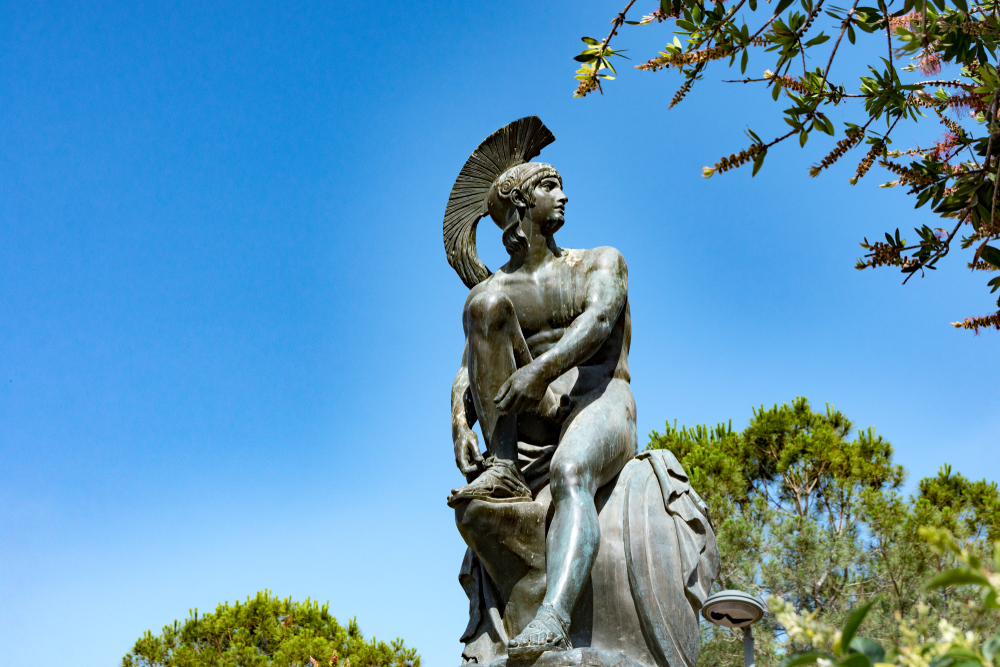Ariadne is a captivating figure in Greek mythology, known for her role in the myth of the Minotaur and her connection to both Theseus and Dionysus. Let’s explore her mythology, powers, symbols, and the myths that have made her an enduring figure in both ancient and modern times.
Jump to:
- Who is Ariadne in Greek Mythology?
- What is Ariadne the Goddess of?
- The Myths and Legends of Ariadne
- The Symbols of Ariadne
- What Powers Does Ariadne Have?
- Ariadne's Relationships, Children, and Family Tree
- The Moral of the Story: Lessons from Ariadne
- Ariadne's Worship and Legacy
- Frequently Asked Questions About Ariadne
- Study Greek Mythology for £29
Recommended for you!
Best SellersWho is Ariadne in Greek Mythology?
Ariadne is a key figure in Greek mythology, recognised as the daughter of King Minos of Crete and Queen Pasiphae. She is best known for her role in aiding the hero Theseus in navigating the labyrinth to slay the Minotaur, her half-brother.
What is Ariadne the Goddess of?

Although Ariadne is not a goddess in the strictest sense at the beginning of her myth, she later becomes associated with divinity through her marriage to Dionysus. As the wife of the god of wine and revelry, Ariadne became linked to fertility, passion, and the changing of the seasons. Some myths suggest that her divine status was a gift from Dionysus, who made her immortal upon their union.
In some accounts, Ariadne is seen as a symbol of renewal and life cycles, often connected to the natural rhythms of the earth, much like her husband. While she is not a central figure like Athena or Hera, her association with Dionysus elevated her to divine status, where she is worshipped alongside him in some regions of the ancient world.
The Myths and Legends of Ariadne
Ariadne’s story has been told in various ways throughout Greek mythology, with each version offering a unique perspective on her life and experiences. Let’s explore three of the most famous myths associated with Ariadne, from her role in the Minotaur’s defeat to her divine marriage to Dionysus.
The Minotaur and Ariadne's Thread
One of the most well-known myths involving Ariadne centres around her role in helping Theseus defeat the Minotaur. Her father, King Minos, demanded that Athens send tributes to Crete to be sacrificed to the Minotaur, a fearsome creature with the body of a man and the head of a bull, confined in a complex labyrinth. Theseus, an Athenian hero, volunteered to kill the beast and end the suffering of his people.
Captivated by Theseus, Ariadne gave him a ball of thread—now famously referred to as "Ariadne's thread"—so he could find his way out of the labyrinth after defeating the Minotaur. Thanks to Ariadne's quick thinking, Theseus was able to slay the creature and escape the maze.
The Abandonment on Naxos
After the triumph over the Minotaur, Theseus and Ariadne fled Crete together. However, as they journeyed back to Athens, Theseus abandoned Ariadne on the island of Naxos.
Different versions of the myth offer varying explanations for this betrayal. In some, Theseus forgot about Ariadne due to divine intervention, while other versions suggest a more deliberate abandonment.
Regardless of the reason, this moment of betrayal marks a turning point in Ariadne's life. Alone on the island, her fate seemed uncertain until the god Dionysus found her.
Dionysus and Ariadne's Divine Marriage
On the island of Naxos, Ariadne’s life took a dramatic turn. Dionysus, the god of wine and revelry, discovered her and immediately fell in love. In some versions of the myth, he found her sleeping, which added a layer of enchantment to their meeting. Upon making Ariadne his wife, Dionysus granted her immortality.
This version of the myth is immortalised in Titian's famous painting "Bacchus and Ariadne," which captures the moment of her transformation from a mortal woman to a divine figure, destined to be worshipped alongside Dionysus.
The Symbols of Ariadne

Ariadne’s story is rich with symbolic meaning, and several key symbols have come to represent her role and legacy in mythology:
- Ariadne’s Thread: Perhaps the most iconic symbol associated with Ariadne is the thread she gave to Theseus to navigate the labyrinth. This thread represents guidance, intelligence, and the ability to find your way through confusion or difficulty. Today, "Ariadne’s thread" has evolved into a metaphor for solving complex problems, highlighting the importance of clarity and insight in the midst of chaos.
- The Crown or Garland: Ariadne is often depicted wearing a crown or garland, which was a gift from Dionysus. This symbolises her divine connection and her eventual ascent to immortality. According to some myths, her crown was transformed into the constellation Corona Borealis after her death, marking her place among the stars.
- Ivy and Vines: Due to her connection to Dionysus, Ariadne is also symbolised by ivy and vines, which represent fertility, growth, and the cyclical nature of life. These natural symbols highlight her association with renewal and the abundance of the earth.
What Powers Does Ariadne Have?
Ariadne's powers in Greek mythology are not the overt abilities of battle or magic, like those of the gods, but her strength lies in her intelligence, resourcefulness, and adaptability. By providing Theseus with the thread, she demonstrates quick thinking and strategic planning—qualities not often emphasised in female characters of mythology at the time.
After her marriage to Dionysus, Ariadne gains a more divine set of powers. Some versions of the myth suggest that she became immortal and was granted eternal youth. In this divine role, she embodies the cycles of life, death, and rebirth, particularly through her association with Dionysus and the changing seasons.
Ariadne's Relationships, Children, and Family Tree
Ariadne’s lineage and relationships in Greek mythology connect her to both mortal and divine figures, showcasing her significance across multiple myths.
- Parentage: Ariadne was the daughter of King Minos of Crete, a powerful and often ruthless ruler, and Queen Pasiphae, who was the daughter of Helios, the sun god.
- Siblings: Ariadne had several notable siblings, including Phaedra, who would later marry Theseus, and Deucalion, a warrior who fought in the Trojan War. Her family’s influence extended across many of the famous myths of ancient Greece. Ariadne’s connection to Theseus briefly brought her into the Athenian royal family before her fateful abandonment.
- Romantic Relationships: Ariadne’s most significant relationships were with Theseus, whom she helped defeat the Minotaur, and Dionysus, who became her husband after Theseus left her. While Theseus betrayed her, Dionysus’ love for Ariadne led to her immortalisation, making her his divine consort.
- Children: With Dionysus, Ariadne had several children, including Oenopion, the god of winemaking, and Staphylus, whose name translates to "grape cluster," linking their lineage to themes of fertility, harvest, and abundance. Her children further reinforced her association with the natural world and the cycles of growth and renewal.
The Moral of the Story: Lessons from Ariadne

The story of Ariadne holds several lessons that resonate even today. Her journey teaches us about the complexities of love and trust, as well as the consequences of betrayal. Ariadne’s abandonment by Theseus shows that even heroes can fail to live up to expectations, while her eventual marriage to Dionysus symbolises redemption and new beginnings.
Her intelligence and resourcefulness are qualities to admire, especially in the context of ancient myths where women were not always given such roles. Ariadne's ability to navigate complex situations, both literal and metaphorical, makes her a symbol of strength and perseverance.
Ariadne's Worship and Legacy
Although Ariadne is not one of the primary deities of the Greek pantheon, she was worshipped in some regions, especially in connection with Dionysus. Festivals in honour of the god often included her as a central figure, celebrating their union and the fertility they represented.
Her legacy extends beyond ancient Greece, with the myth of Ariadne continuing to inspire art, literature, and modern interpretations. Paintings such as "Bacchus and Ariadne" by Titian keep her story alive, while her name and symbols appear in various forms of modern culture, from literature to film.
Recommended for you!
Best SellersFrequently Asked Questions About Ariadne
How do you pronounce the word Ariadne?
Ariadne is pronounced as "Ah-ree-AD-nee." The emphasis is on the second syllable, with the "dne" part pronounced as two distinct syllables.
What does the name Ariadne mean in Greek?
The name Ariadne originates from ancient Greek and means "most holy" or "utterly pure." It reflects her revered status in mythology, especially after becoming the divine wife of Dionysus.
Why was Ariadne killed in some myths?
While many versions of Ariadne's story end with her becoming immortal, some accounts suggest that she was killed by the goddess Artemis. This version is less common and is thought to reflect the rivalry between divine powers, or a punishment for past actions.
Did Theseus marry Ariadne's sister?
After abandoning Ariadne, Theseus eventually married her sister, Phaedra. This adds another layer of drama to the story, as Phaedra herself becomes embroiled in her own tragic love story with Theseus’ son, Hippolytus.
Study Greek Mythology for £29
Interested in learning more about Greek mythology and the incredible stories of gods, heroes, and mythical creatures like Pegasus? At Centre of Excellence, you can enrol in our Greek Mythology Diploma Course for just £29. This course offers a look at the fascinating world of ancient Greece, exploring the myths and legends that have shaped Western culture for centuries.













